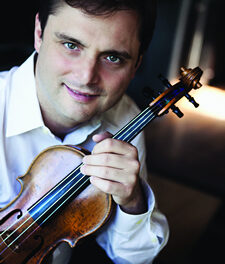Music for wind ensemble tends to be regarded as inferior to chamber music for strings. The latter is a genre in which any composer after Haydn had to achieve in order to be taken seriously; in the former category, success was optional. Yet, on Sunday evening, November 13, the Carolina Winds reminded a Chamber Music Society of Wilmington audience just how rich the repertoire for winds really is, performing a well-balanced program of John Steinmetz, Carl Nielsen, and Mozart. The first half of the concert featured Elizabeth Ransom, flute/piccolo, Petrea Warneck, oboe/English horn, Christopher Grymes, clarinet, Christopher Ulffers, bassoon, and Robert Campbell, horn.
Eschewing a traditional program sequence, the ensemble began with Steinmetz’s Quintet for wind instruments, composed in 1984. The work, comprised of seven sections performed without pause, is something of a ruminative essay on a single note, A, which binds the movements together. The piece commences with a Prelude, during which the performers “explore” the note as if trying it out for the first time, testing what blends and what clashes with the fundamental tone. The Carolina Winds took the composer’s opening idea even further by blurring the line between their tuning and the start of the actual work, and as a listener it was fun to be caught off guard.
In the second section of the Quintet, Warneck demonstrated her superb ability to phrase, creating lines with beautiful syntax. In the third movement, however, it was Campbell’s and Grymes’ choice not to add any lyrical phrasing to a chant-like duet that was apropos of Steinmetz’s reference to the medieval monastery. Soon after the chant, the composer shifts eras and offers the listener something akin to Renaissance dance music. Ransom and Ulffers captured the spirit of the tune perfectly. In the slower middle movements, Ransom was technically flawless, but I thought her playing could have conveyed more emotion at times. A similar quibble involves the penultimate movement, “Canon,” in which Grymes might have entered late a time or two. Overall, however, the piece was performed exceptionally well, and the players’ focus was admirable.
Second on the program was Danish composer Carl Nielsen’s Quintet (1922) a pleasant, post-Romantic work that looks back fondly on the 19th century. Ulffers began the work with an easy-going melody, but when the other instruments entered a few bars later, there seemed to be a disagreement about tempo; soon, however, a decision was reached. Though I thought the center section could have expressed a greater contrast of mood, throughout the first movement each performer clearly brought out his or her lines when required and appropriately remained in the background when part of the accompaniment. Grymes’ second movement solo was particularly nice, as was Ransom’s flute cadenza in the introduction to the final movement. Campbell should also be singled out for a very well played solo during one of the variations toward the end of the work, in which the horn is completely exposed.
In keeping with the Chamber Music Society of Wilmington’s observance of the 250th anniversary of Mozart’s birth this January, the second half of the program was devoted to his music. Drafting from among their students to create an octet of oboes, clarinets, bassoons, and horns, the ensemble was joined by Robert Smith, oboe, Pam Garofolo, clarinet, Shrieka Gillaird, bassoon, and Laura Carter, horn. They began with an arrangement of the Overture to The Marriage of Figaro, a setting transcribed during Mozart’s own time. This was the only point during the evening when I missed the strings, especially during the first forte in the opening few seconds of the overture. When this moment arrived, it just didn’t have the excitement of the original version. This shortcoming, of course, lies not with the performers but with the arrangement, which – in its defense – was probably never intended for anything more than music at a party.
The final work on the program had much more weight: Mozart’s Serenade in C minor, K.388, composed in the early 1780s. Though the rise in status of the string quartet over the wind ensemble stems from the late 18th-century, a piece such as this prompts one to reconsider whether or not composers like Mozart viewed the hierarchy as such. Plainly put, the work is profound, and the performers did it considerable justice. Special mention should go to the motor-like runs in the bassoon during the first movement, the operatic playing of the clarinet during the Andante, and the lovely oboe parts in the Trio of the third movement. The student performers were well chosen and contributed to a level of musicianship established from the beginning of this concert, one in which flaws were few and artistry was abundant.
Note: Stuart Burnham writes the program notes for the Chamber Music Society of Wilmington.












